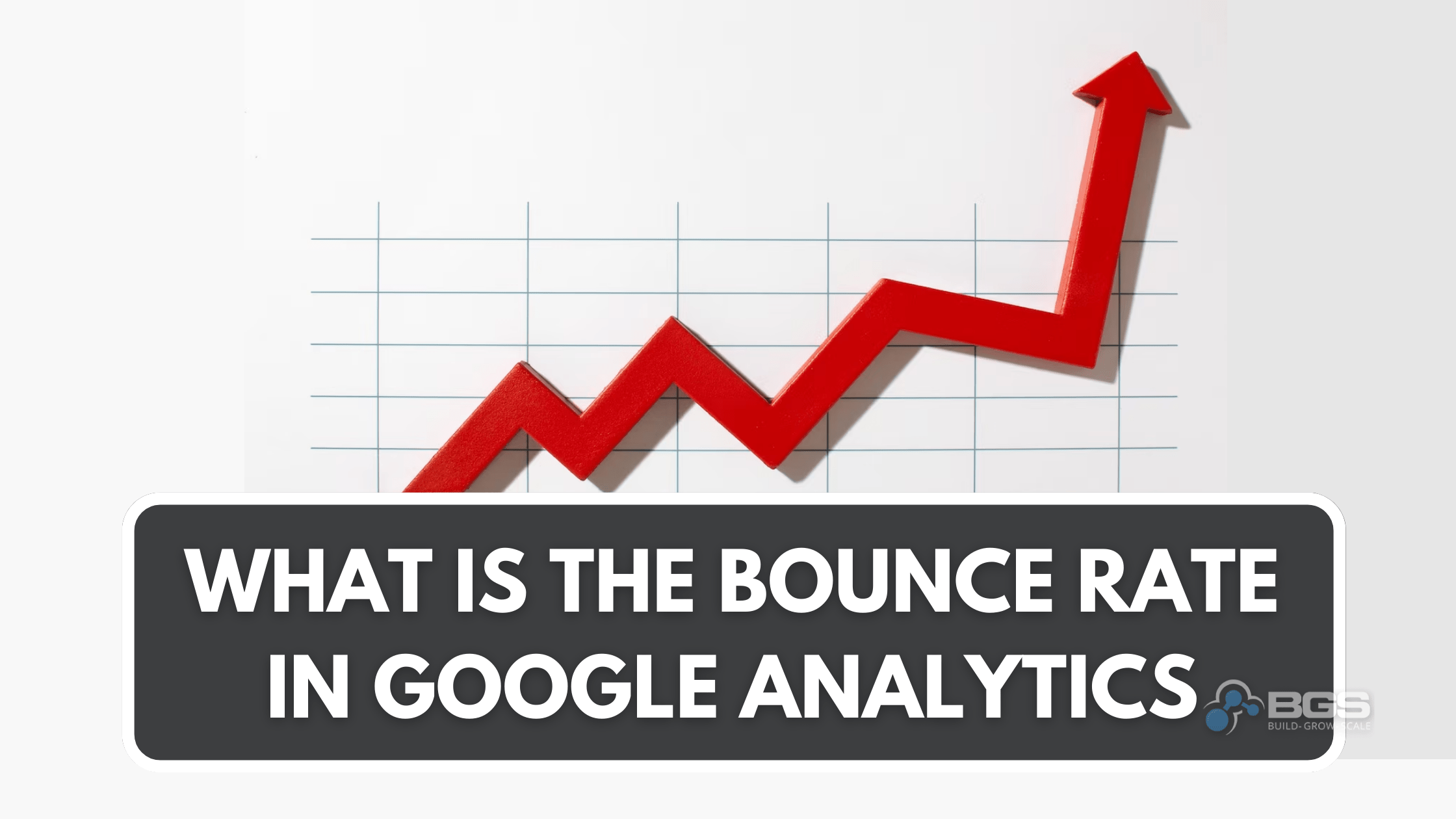Understanding What Is the Bounce Rate in Google Analytics and Why it Matters

Dominik Meiu | Aug 17, 2023
Reading Time: 5 minutesEver wondered what ‘bounce rate’ means in Google Analytics? You’re not alone. It’s a key metric that can tell you a lot about your website’s performance, but it’s often misunderstood. Don’t worry, we’ve got you covered. In this guide, we’ll break down what is the bounce rate in Google Analytics, how it impacts conversion rate, what a good bounce rate looks like, and how you can lower it.
Let’s dive in!
What is the bounce rate in Google Analytics?
You’re probably wondering what the ‘bounce rate’ in Google Analytics is, aren’t you? Don’t worry, it’s not as complicated as it sounds. It’s essentially a metric that measures the percentage of visitors who land on your website and do nothing on the page they enter. This means they don’t click on a menu item, a ‘read more’ link, or any other internal links on the page.
So, why should you care about the bounce rate in Google Analytics? Well, it’s a vital piece of data for customer acquisition. If you’ve got a high bounce rate, it might mean that people aren’t finding what they’re looking for or your website isn’t user-friendly. That’s not good for business.
Moreover, a high bounce rate can also impact your brand loyalty. If visitors bounce off without engaging, they’re less likely to remember your brand or return to your site. So, it’s in your best interest to reduce that bounce rate. It’s one of the most effective ways to increase customer engagement, improve brand loyalty, and boost your bottom line.
Does Bounce Rate Affect Conversion Rate?
It’s important to consider if a high exit percentage from your site could be impacting your overall conversions. Remember, bounce rate in Google Analytics is the percentage of single-page visits to your site, where users leave without interacting further. A high bounce rate could indicate that visitors aren’t finding what they’re looking for or aren’t enticed to explore more of your site.
This might be hurting your conversion rate. Think about it. If users are leaving your site without engaging, they’re not signing up for newsletters, downloading your e-book, or making a purchase. They’re not converting.
But don’t panic just yet! A high bounce rate doesn’t always signal disaster. It depends on the purpose of your site. For instance, if you’re running a blog, a high bounce rate might simply mean visitors quickly find the information they need and leave.
However, if you’re in e-commerce, a high bounce rate is a red flag. It suggests you’re not hooking visitors or persuading them to buy. You’ll want to dig deeper into your analytics, identify problem areas, and make necessary improvements. Remember, turning visitors into customers is the name of the game.
What’s a good bounce rate?
Determining what’s considered a decent exit percentage from your site can greatly depend on the industry and the specific goals of your online platform. However, you can use general guidelines to gauge if your bounce rate is on track.
Generally, a bounce rate between 26% to 40% is excellent, 41% to 55% is roughly average, and 56% to 70% is higher than average but could be expected depending on the website. Anything over 70% is disappointing for everything outside of blogs, news, events, etc.
But remember, these are just guidelines. It’s essential for you to understand your site’s individual needs and goals. You might be running a blog and be perfectly happy with a 70% bounce rate. On the other hand, if you’re running an e-commerce store, a high bounce rate could indicate issues with your product pages or checkout process.
Moreover, always keep an eye on your bounce rate over time. It might be time to investigate and troubleshoot potential issues if it’s gradually increasing. After all, your site’s success depends on keeping your audience’s attention and encouraging them to engage.
What’s the difference between bounce rate and exit rate?
Let’s delve into the distinction between how often visitors leave your site after viewing only one page versus the frequency of them leaving after viewing multiple pages. This disparity is best explained by understanding the difference between bounce rate and exit rate.
Your bounce rate represents the percentage of visitors who enter your site and then leave rather than continuing to view other pages. In other words, they’ve ‘bounced’ off your site after only seeing one page. It’s the digital equivalent of walking into a store, looking around for a minute, and walking out.
On the other hand, your exit rate refers to the percentage of visitors who leave from a specific page, regardless of how many pages they’ve visited prior. If a visitor browses multiple pages on your site before deciding to leave, that’s recorded in your exit rate. It’s like a customer in a store who walks around, checks out several aisles, and then decides to leave.
How can I lower the bounce rate?
You’re probably wondering how to reduce the percentage of visitors leaving your site after viewing only one page. Don’t worry, it’s not as hard as you might think. Here are a few effective strategies.
- First off, make sure your site’s design is engaging and user-friendly. A confusing layout or poor mobile optimization can send visitors packing. Invest in quality design and navigation, and you’re likely to see your bounce rate decrease.
- Secondly, consider your content. Is it relevant and valuable to your audience? If not, it’s time to step up your game. Create content that’s interesting, useful, and keeps visitors on your site longer. Don’t forget to break it up with images and headings for easy reading.
- Lastly, check your site’s speed. Slow-loading pages are a major contributor to high bounce rates. Optimize images, reduce server response time, and consider a content delivery network to speed things up.
Final Thoughts: What is the bounce rate in Google Analytics
Now that you understand what is the bounce rate in Google Analytics, you are aware that it is a crucial metric to keep track of. It can impact your conversion rate and indicates how engaging your website is.
Aim for a lower bounce rate, but remember, what’s considered ‘good’ can vary. Don’t confuse it with exit rate, they’re different.
If your bounce rate is high, don’t sweat it. There are plenty of strategies you can implement to bring it down. Stay proactive, and you’ll see improvements.
Frequently Asked Questions
The significance of bounce rate in SEO ranking is substantial. It’s a measure of visitor engagement on your site. High bounce rates might indicate poor user experience, potentially hurting your ranking in search results.
Yes, a high bounce rate can potentially lead to website penalization by Google. It’s viewed as a signal that your site might not be providing valuable content, which can hurt your search engine rankings.
The type of content greatly impacts your website’s bounce rate. If it’s engaging and valuable, visitors will stay longer, reducing your bounce rate. Conversely, poor or irrelevant content can increase your bounce rate significantly.
Yes, there’s a correlation between bounce rate and website loading speed. If your site loads slowly, visitors might leave before interacting, thus increasing your bounce rate. It’s crucial to optimize your site’s speed.
Yes, bounce rates can vary across different industries and websites. Factors like user experience, content relevance, and industry norms heavily influence this. It’s vital to benchmark against similar sites or industries.



Table of Contents
What is the bounce rate in Google Analytics?Does Bounce Rate Affect Conversion Rate?What’s a good bounce rate?What’s the difference between bounce rate and exit rate?How can I lower the bounce rate?Final Thoughts: What is the bounce rate in Google AnalyticsFrequently Asked QuestionsTable of ContentsAbout the authorLeave a Comment Cancel ReplyAbout the author
Dominik Meiu
Dominik is a Revenue Optimization expert for Build Grow Scale. He loves the bright environment the team provides and the fact that he can have fun at work. The source of his incredible powers and critical game-changing ideas lay in his beautiful, luxurious, and youthful head of hair.




